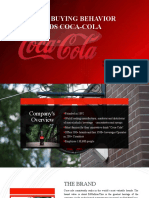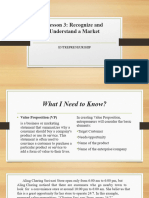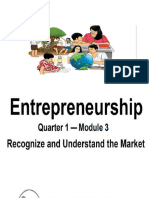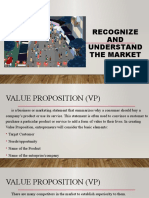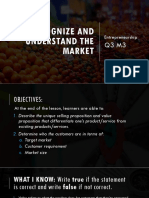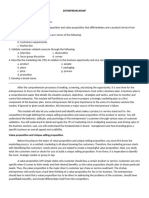0 ratings0% found this document useful (0 votes)
33 viewsMath
Math
Uploaded by
Sandarha NaiveThis document provides information on understanding potential markets for entrepreneurs. It discusses value propositions, unique selling propositions, target markets, customer requirements, and market size. Value propositions summarize why customers should buy a product and consider customer needs. Unique selling propositions differentiate a product from competitors. Target markets are groups of customers with common characteristics. Customer requirements include tangible output needs and intangible service expectations. Market size estimates the potential number of customers in a given area based on market research.
Copyright:
© All Rights Reserved
Available Formats
Download as PPTX, PDF, TXT or read online from Scribd
Math
Math
Uploaded by
Sandarha Naive0 ratings0% found this document useful (0 votes)
33 views20 pagesThis document provides information on understanding potential markets for entrepreneurs. It discusses value propositions, unique selling propositions, target markets, customer requirements, and market size. Value propositions summarize why customers should buy a product and consider customer needs. Unique selling propositions differentiate a product from competitors. Target markets are groups of customers with common characteristics. Customer requirements include tangible output needs and intangible service expectations. Market size estimates the potential number of customers in a given area based on market research.
Copyright
© © All Rights Reserved
Available Formats
PPTX, PDF, TXT or read online from Scribd
Share this document
Did you find this document useful?
Is this content inappropriate?
This document provides information on understanding potential markets for entrepreneurs. It discusses value propositions, unique selling propositions, target markets, customer requirements, and market size. Value propositions summarize why customers should buy a product and consider customer needs. Unique selling propositions differentiate a product from competitors. Target markets are groups of customers with common characteristics. Customer requirements include tangible output needs and intangible service expectations. Market size estimates the potential number of customers in a given area based on market research.
Copyright:
© All Rights Reserved
Available Formats
Download as PPTX, PDF, TXT or read online from Scribd
Download as pptx, pdf, or txt
0 ratings0% found this document useful (0 votes)
33 views20 pagesMath
Math
Uploaded by
Sandarha NaiveThis document provides information on understanding potential markets for entrepreneurs. It discusses value propositions, unique selling propositions, target markets, customer requirements, and market size. Value propositions summarize why customers should buy a product and consider customer needs. Unique selling propositions differentiate a product from competitors. Target markets are groups of customers with common characteristics. Customer requirements include tangible output needs and intangible service expectations. Market size estimates the potential number of customers in a given area based on market research.
Copyright:
© All Rights Reserved
Available Formats
Download as PPTX, PDF, TXT or read online from Scribd
Download as pptx, pdf, or txt
You are on page 1of 20
ENTREPRENEURSHIP
Recognize and Understand the
Market
Let’s see if you already have some idea about Recognizing
Potential Markets.
Write True if the statement is correct and write False if not
correct.
__________1. Value refers to what the product does for
customers that they’re prepared to pay.
__________2. Marketing concept that was first proposed as a
theory to understand the pattern in successful advertising
called Unique Selling Proposition.
__________3. In creating value proposition, entrepreneurs will
consider the four (4) basic elements.
__________4. Unique selling proposition is specific, often
citing numbers or percentages.
__________5. The effective selling using advertising and
marketing is part of value proposition.
__________6. Identify and rank the uniqueness of the product
or services character is one tip for the entrepreneur on how to
create an effective unique selling proposition.
__________7. The Entrepreneurs will not consider the health
benefits of the consumers.
__________8. Consumers have common wants and needs.
__________9. The market targeting is a stage in market
identification process that aims to determine the set of buyers
with common needs and characteristics.
_________10. Identifying the unique selling proposition will
not require marketing research.
_________11. Targeting a specific market does not mean that
you are excluding people who do not fit your criteria.
_________ 12. Demographic segmentation is the total market
divided according to geographic location.
_________ 13. Knowledge and awareness is one variable to
consider in behavioral segmentation.
_________ 14. Service requirement is intangible thing or
product not able to be touch but feel the fulfillment.
_________ 15. Market size is like a world globe measurement.
You are done in recognizing potential markets as the second Topic
in entrepreneurship. You already understand the best product or
service that will meet the market need. Now, you will continue to
learn more about markets, recognize and understand the market.
Everyone can create a business vicinity map reflective of potential
market in one’s locality/town.
This lesson is divided into two topics:
1 – Describe the unique selling proposition and value proposition
that differentiate one’s product/service from existing
products/services.
2 – Determine who the customers are in term of
a. Target market
b. Customer requirement
c. Market size
In previous lesson we learn about the creation of an
entrepreneurial ideas that lead to the identification of
entrepreneurial opportunities, which in turn results in the
opening of an entrepreneurial venture. In opening the new
venture or a business, you need to determine the Unique
Selling Proposition (USP) and Value Proposition (VP) of your
product as well as your target market.
Value Proposition (VP) is a business or marketing statement
that summarizes why a consumer should buy a company's
product or use its service. This statement is often used to
convince a customer to purchase a particular product or
service to add a form of value to their lives.
In creating Value Proposition, entrepreneurs will consider the
basic elements:
• Target Customer
• Needs/opportunity
• Name of the product
• Name of the enterprise/company
There are many competitors in the market to establish superiority to them.
Entrepreneurs should think some alternative and how it works better. An
important aspect in Value Proposition must be truthful that will establish
credibility to the consumers.
Example: Potential value proposition is most common in small businesses
of your locality.
Aling Charing Sari-sari Store open only from 6:00 am to 6:00 pm, but Aling
Charing noticed that there are customers who go nearby town to look for a
convenience store at around 10:00 pm to 6:00 am. She believes that this is
a great opportunity for her store to operate 24/7. In this example, proposed
value proposition: “Charing Sari-sari Store, opens 24/7”.
The business describes sari-sari store – a basic retail store. The assurance
from this value proposition is because of the phrase “opens 24/7”, Aling
Charing Sari-sari Store opens 24/7, which make it different from other
competitors.
Unique selling proposition (USP) refers to how you sell your
product or services to your customer. You will address the
wants and desires of your customers.
As entrepreneur, you think of marketing concept that persuade
your target customers. The following questions you may ask in
doing this, What the customers want? What brand does well?
What your competitor does well?
Some tips for the entrepreneur on how to create an effective unique
selling proposition to the target customers:
• Identify and rank the uniqueness of the product or services
character
• Very Specific
• Keep it short and simple (KISS)
As entrepreneur, present the best feature of your product or
services that are different from other competitors. Identifying the
unique selling proposition requires marketing research that you will
learn from the other modules. In promoting your products or
services, make sure that it is very specific and put details that
emphasize the differentiator against the competitors. Keep it short
and simple and think of a tagline that is easy to remember. Right
now, the proposed unique selling proposition: “Charing Sari-sari
Readers get confused between value proposition and unique
selling proposition. The two propositions are used to
differentiate the products from competitors.
For example, Jollibee is known to have a Filipino taste burger.
This brand has a unique selling point because of its tagline
“Langhap Sarap”
Unique Value Proposition and Value Proposition are two most
famous tools used to explain why prospect customers buy
each products and services. Base on each definition, we learn
that USP and VP are frameworks of each business industry.
The two propositions are valuable for the entrepreneurs.
After you understand the value proposition and the unique selling
proposition, now it’s time to understand the target market, customers
requirement and market size.
A. Target Market
Market Targeting is a sage in market identification process that aims to
determine the buyers with common needs and characteristics.
Prospect customers are market segment that entrepreneurial venture
intends to serve.
In targeting a specific market, it will exclude people even if it will not fit
your criteria. Rather, target marketing allows you to focus your
marketing money and brand message on a specific market that is
more likely to buy from you than other markets. Product is more
affordable, efficient, and effective way to reach potential clients and
generate business.
Commonly used methods for segmenting the market are
follows.
1. Geographic segmentation – the total market is divided
according to geographical location.
• Variable to consider
a. Climate
b. Dominant ethnic group
c. Culture
d. Density (either rural or urban)
2. Demographic Segmentation – divided based consumers.
• Variable to consider
a. Gender
b. Age
c. Income
d. Occupation
e. Education
f. Religion
g. Ethnic group
h. Family size
3. Psychological Segmentation- divided in terms for customers
think and believe.
• Variable to consider
a. Needs and wants
b. Attitudes
c. Social class
d. Personality traits
e. Knowledge and awareness
f. Brand concept
g. Lifestyle
4. Behavioral Segmentation- divided according to customers
behavior pattern as they interact with a company.
• Variable to consider
a. Perceptions
b. Knowledge
c. Reaction
d. Benefits
e. Loyalty
f. Responses
B. Customer Requirements
Customer requirements are the specific characteristics that
the customers need from a product or a service.
There can be two types of customer requirements:
1. Service Requirement
2. Output Requirement
Service Requirement:
Intangible thing or product that is not able to be touched but
customer can feel the fulfillment. There are elements in
service requirement like on-time delivery, service with a smile,
easy-payment etc. It includes all aspects of how a customer
expect to be treated while purchasing a product and how easy
the buying process goes.
Output Requirements:
Tangible thing or things that can be seen. Characteristic specifications
that a consumer expects to be fulfilled in the product. Costumer that
will avail services as a product, then various service requirements can
take the form of output requirements. For example, if the consumer
hires a multi cab, then on-time arrival becomes an output requirement.
Customer buys gadgets (phone speaker), the specification like the
loudness and clarity are the output requirements.
C. Market Size
Entrepreneur’s most critical task is to calculate the market size, and
the potential value that market has for their startup business. Market
research will determine entrepreneur possible customers in one
locality.
What is Market Size?
Market size is like a size of arena where the entrepreneurs will play
their business. It is the approximate number of sellers and buyers in a
particular market. Companies are interested in knowing the market size
before launching a new product or service in the area. In determining
the market size, entrepreneur will conduct a strategic marketing
research from reliable sources using the following method. First step is
to estimate the potential market – approximate number of customers
that will buy the product or avail your services. Second step is to
estimate the customers who probably dislike to buy your product or
avail the services. Third step is for the entrepreneur to estimate the
market share, that means plotting and calculating of the competitor’s
market share to determine the portion of the new venture. Market size
become the most important if you ever need to raise funding for your
business.
You might also like
- Estmt - 2022 08 18Document4 pagesEstmt - 2022 08 18CHRIS100% (1)
- Forms of Online: Threats and HarassmentDocument11 pagesForms of Online: Threats and HarassmentSandarha NaiveNo ratings yet
- Handouts For 7th Edition Call of CthulhuDocument36 pagesHandouts For 7th Edition Call of CthulhuGabriel DiasNo ratings yet
- Recognizing and Understanding The Market in AnimationDocument4 pagesRecognizing and Understanding The Market in AnimationCeejay Afinidad100% (1)
- Consumer Buying Behavior Towards Coca-ColaDocument10 pagesConsumer Buying Behavior Towards Coca-ColaMitali Mishra67% (3)
- Entrepreneurship Recognize & Understand The MarketDocument17 pagesEntrepreneurship Recognize & Understand The MarketChristine Joy AdvientoNo ratings yet
- Entrepreneurial Mind FrameDocument3 pagesEntrepreneurial Mind FrameJelian MontenegroNo ratings yet
- Recognize and Understand The MarketDocument7 pagesRecognize and Understand The MarketchavezshenahkateNo ratings yet
- Entrepreneurship Module 3Document57 pagesEntrepreneurship Module 3Prince Jay MartinezNo ratings yet
- LAS-quarter-1-week-3Document5 pagesLAS-quarter-1-week-3venicevarona18No ratings yet
- Recognize and Understand The MarketDocument5 pagesRecognize and Understand The Marketjulio abanadorNo ratings yet
- Entrep Module 3 - Week 4Document27 pagesEntrep Module 3 - Week 4lester.ladigonNo ratings yet
- Entrepreneurship Q1 - WK4 6Document9 pagesEntrepreneurship Q1 - WK4 6Sagi CreatesNo ratings yet
- Recognize and Understand The MarketDocument26 pagesRecognize and Understand The Marketdesiree escolinNo ratings yet
- Weeks 7-8Document5 pagesWeeks 7-8eliagracechellemaeNo ratings yet
- Q1-WEEK-4-5-LECTURE-NOTES-RECOGNIZE-THE-POTENTIAL-MARKET-ENTREP.-CANSINODocument2 pagesQ1-WEEK-4-5-LECTURE-NOTES-RECOGNIZE-THE-POTENTIAL-MARKET-ENTREP.-CANSINOhdgsvdbnfNo ratings yet
- Entrepq1 3Document37 pagesEntrepq1 3Juvy Fernandez Abong DejesaNo ratings yet
- Edited 3Document8 pagesEdited 3RODEL DESABILLENo ratings yet
- Recognize and Understand The MarketDocument21 pagesRecognize and Understand The MarketBelen GonzalesNo ratings yet
- Entrep 3Document6 pagesEntrep 3Eddie PagalanNo ratings yet
- Module3 Entrepreneurship G12 RevisedDocument13 pagesModule3 Entrepreneurship G12 RevisedJearim MalicdemNo ratings yet
- 12- ARISTOTLE GROUP 3 Orange Organic Planning Techniques for Students Presentation (1)Document13 pages12- ARISTOTLE GROUP 3 Orange Organic Planning Techniques for Students Presentation (1)cherry tarucNo ratings yet
- Entrep Week3Document2 pagesEntrep Week3Celeste BatraloNo ratings yet
- Recognize and Understand The MarketDocument39 pagesRecognize and Understand The MarketCyra Mae Ladiao-GarciaNo ratings yet
- Las in Entrepreneurship Week 4Document5 pagesLas in Entrepreneurship Week 4IMELDA CORONACIONNo ratings yet
- Entrepreneurship Module 3Document6 pagesEntrepreneurship Module 3Naila PangcogaNo ratings yet
- Entrepreneurship PPT Q1 MODULE 3 1Document22 pagesEntrepreneurship PPT Q1 MODULE 3 1Bevialyn Valdez BuenaflorNo ratings yet
- Week 3Document8 pagesWeek 3xtneNo ratings yet
- Lesson 3 Recognize The MarketDocument41 pagesLesson 3 Recognize The Marketrizamiaramos10No ratings yet
- Recognize and Understand The Market - PPTDocument56 pagesRecognize and Understand The Market - PPTRodel laman100% (7)
- Lesson 3 Recognize and Understand The Market Week 23Document27 pagesLesson 3 Recognize and Understand The Market Week 23May Anne FranciscoNo ratings yet
- Entrepreneurship Mod3 Recognize and Understand A MarketDocument14 pagesEntrepreneurship Mod3 Recognize and Understand A MarketEver BrandinoNo ratings yet
- ENTREPRENEURSHIP Week 3Document17 pagesENTREPRENEURSHIP Week 3lydi ibiezaNo ratings yet
- Entrep12 Q1 Mod3 Recognize-and-Understand-the-Market v2Document13 pagesEntrep12 Q1 Mod3 Recognize-and-Understand-the-Market v2MrBigbozz21No ratings yet
- Mod3 - Recognize and Understand The Market - v2Document13 pagesMod3 - Recognize and Understand The Market - v2Kulafo VinoNo ratings yet
- EntrepDocument41 pagesEntrepKristel AshleyNo ratings yet
- Lesson 1 - W3 - Entrep StudentsDocument26 pagesLesson 1 - W3 - Entrep StudentsdeodatobanaganNo ratings yet
- LESSON3 Recognize and Understand The MarketDocument36 pagesLESSON3 Recognize and Understand The Marketkenvaflor98No ratings yet
- Week 3 EntrepDocument4 pagesWeek 3 EntrepMalia MedalNo ratings yet
- Entrepreneurship Lesson 3Document23 pagesEntrepreneurship Lesson 3Cj EvalleNo ratings yet
- Q3-M3-ENTREP-LECTUREDocument8 pagesQ3-M3-ENTREP-LECTURENennsha NagudNo ratings yet
- Recognize and Understand The MarketDocument22 pagesRecognize and Understand The Marketpste oyNo ratings yet
- Lesson 3 - Recognize and Understand The MarketDocument18 pagesLesson 3 - Recognize and Understand The MarketMarivie Da-arol ElicNo ratings yet
- LAS 3, Week 4Document13 pagesLAS 3, Week 4Marife CulabaNo ratings yet
- Entre 12 L2Document43 pagesEntre 12 L2lharycele08No ratings yet
- Ent-2 1Document7 pagesEnt-2 1Lee Angel ReloxNo ratings yet
- Lesson 3 EntrepDocument51 pagesLesson 3 EntrepAyessa DaneNo ratings yet
- Clientele and Audiences in Communication - 20240314 - 121557 - 0000Document22 pagesClientele and Audiences in Communication - 20240314 - 121557 - 0000Ma. Leilah CuicoNo ratings yet
- Cot 3Document36 pagesCot 3PRECIOUS GRACE SILVANo ratings yet
- Entrep Q1 M3Document8 pagesEntrep Q1 M3Ajea MamalapatNo ratings yet
- Entrep Q3W4 AhoDocument4 pagesEntrep Q3W4 Aho我AnimeXLNo ratings yet
- Recognize and Understand The Market: Entrepreneurship Lesson 3Document27 pagesRecognize and Understand The Market: Entrepreneurship Lesson 3LIBAY, ELIEZA REYNA JANE M.No ratings yet
- Lesson3 - Entrep-Recognize A Market Q1M3Document19 pagesLesson3 - Entrep-Recognize A Market Q1M3Stephen CurryNo ratings yet
- 3 Entrep Recognize and Understand The Market PDFDocument28 pages3 Entrep Recognize and Understand The Market PDFJuberose GillesaniaNo ratings yet
- 3 Recognize and Understand The MarketDocument32 pages3 Recognize and Understand The Marketjeciedump1No ratings yet
- Chapter 3 ENTRP 101Document10 pagesChapter 3 ENTRP 101rhyshryroch royerasNo ratings yet
- ReportingDocument15 pagesReportingBea SancoverNo ratings yet
- Marketing in AnimationDocument4 pagesMarketing in AnimationJamaica PinaNo ratings yet
- Entrepreneurship-Module 3Document20 pagesEntrepreneurship-Module 3French PaleteNo ratings yet
- Wk-3-And-4-Entrepreneurship G12 Module LAS and WHLPDocument2 pagesWk-3-And-4-Entrepreneurship G12 Module LAS and WHLPIvy Denise Maranan Dimayuga100% (1)
- Prerequisite Content-Knowledge: Prerequisite Skill: Prerequisites AssessmentDocument7 pagesPrerequisite Content-Knowledge: Prerequisite Skill: Prerequisites AssessmentRachell BondocNo ratings yet
- Recognize and Understand The Market: Prepared By: Alma D. Mendoza Subject Teacher (Entrepreneurship)Document37 pagesRecognize and Understand The Market: Prepared By: Alma D. Mendoza Subject Teacher (Entrepreneurship)Mary glaiza FernandezNo ratings yet
- Market Segmenttaion Report - OdtDocument51 pagesMarket Segmenttaion Report - OdtRachna GoelNo ratings yet
- FINAL DRAFT 3isDocument25 pagesFINAL DRAFT 3isSandarha NaiveNo ratings yet
- HunterDocument8 pagesHunterSandarha NaiveNo ratings yet
- Lesson 5Document37 pagesLesson 5Sandarha NaiveNo ratings yet
- Legal, EthicalDocument2 pagesLegal, EthicalSandarha NaiveNo ratings yet
- Central Mindanao University: Logistics ManagementDocument8 pagesCentral Mindanao University: Logistics ManagementTracy Van TangonanNo ratings yet
- Dokumen - Tips Dubai Islamic Bank Pakistan Internship ReportdocxDocument19 pagesDokumen - Tips Dubai Islamic Bank Pakistan Internship Reportdocxnouman sandhuNo ratings yet
- Chapter 5 PPT 4th EditionDocument34 pagesChapter 5 PPT 4th EditionLê Na100% (1)
- Week2 Discussion AnswersDocument15 pagesWeek2 Discussion AnswersCha BuenaventuraNo ratings yet
- Review of MotivationDocument6 pagesReview of MotivationEaswaryNo ratings yet
- Thesis On Customer Relationship Management in BanksDocument8 pagesThesis On Customer Relationship Management in Banksubkciwwff100% (1)
- MS 06-04 BudgetingDocument3 pagesMS 06-04 BudgetingxernathanNo ratings yet
- Question Book: Covers 900+ ICSI QuestionsDocument94 pagesQuestion Book: Covers 900+ ICSI QuestionsSamiksha PawarNo ratings yet
- MBA Business Law Session 8 Reading. 1Document11 pagesMBA Business Law Session 8 Reading. 1Aniket MishraNo ratings yet
- Location Planning and AnalysisDocument5 pagesLocation Planning and AnalysisSUNNY SIDE UPNo ratings yet
- FABM2 Module 2. Statement of Comprehensive IncomeDocument13 pagesFABM2 Module 2. Statement of Comprehensive IncomeSITTIE RAYMAH ABDULLAHNo ratings yet
- Fin Acc 13Document6 pagesFin Acc 13ilasuhNo ratings yet
- A Study On Consumer's Willingness To Use Eco-FriendlyDocument18 pagesA Study On Consumer's Willingness To Use Eco-FriendlyKrutika GoyalNo ratings yet
- Survey Form - Open Banking - Google FormsDocument21 pagesSurvey Form - Open Banking - Google FormsWendelynn Giannina AngNo ratings yet
- Company ProfileDocument21 pagesCompany ProfileCoping ForeverNo ratings yet
- 6wresearch - Hiring Brochure - Pre Sales (2022)Document12 pages6wresearch - Hiring Brochure - Pre Sales (2022)GautamNo ratings yet
- UDAAN - Case StudyDocument5 pagesUDAAN - Case StudyBeast FoxNo ratings yet
- Strategy Formulating by SWOT and QSPM Matrix (Case Study: Sanitary Ware Company of Golsar Fars)Document15 pagesStrategy Formulating by SWOT and QSPM Matrix (Case Study: Sanitary Ware Company of Golsar Fars)Ummu UmairahNo ratings yet
- STD4172-4 PackagingDocument8 pagesSTD4172-4 PackagingAymen SioudNo ratings yet
- Sprint BillDocument1 pageSprint BillAveeNo ratings yet
- Group 1 Chapter 2 AC8Document22 pagesGroup 1 Chapter 2 AC8Marco LacapNo ratings yet
- MSC CoC Standard CFO v2.0Document20 pagesMSC CoC Standard CFO v2.0Văn Trơn PhanNo ratings yet
- AI and Data Analytics in WarehousingDocument3 pagesAI and Data Analytics in Warehousingbyfgal3No ratings yet
- How To Create A Creative CityDocument5 pagesHow To Create A Creative CityTiago de FariaNo ratings yet
- PDF Marketing Research 13th Edition Kumar downloadDocument40 pagesPDF Marketing Research 13th Edition Kumar downloadsoulefwadhwa100% (3)
- Engineering Economic DecisionsDocument31 pagesEngineering Economic DecisionsRasyid YudhistiraNo ratings yet
- Walden ChuDocument17 pagesWalden Chuallen jierqsNo ratings yet





